|
|
|
Sort Order |
|
|
|
Items / Page
|
|
|
|
|
|
|
| Srl | Item |
| 1 |
ID:
133077
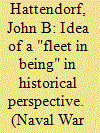

|
|
|
|
|
| Publication |
2014.
|
| Summary/Abstract |
The phrase "fleet in being" is one of those troublesome terms that naval historians and strategists have tended to use in a range of different meanings. The term first appeared in reference to the naval battle off Beachy Head in 1690, during the Nine Years' War, as part of an excuse that Admiral Arthur Herbert, first Earl of Torrington, used to explain his reluctance to engage the French fleet in that battle. A later commentator pointed out that the thinking of several British naval officers ninety years later during the War for American Independence, when the Royal Navy was in a similar situation of inferior strength, contributed an expansion to the fleet-in-being concept. To examine this subject carefully, it is necessary to look at two separate areas: first, the development of the idea of the fleet in being in naval strategic thought, and, second, the ideas that arose in the Royal Navy during the War of the American Revolution.
|
|
|
|
|
|
|
|
|
|
|
|
|
|
|
|
| 2 |
ID:
133078
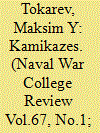

|
|
|
|
|
| Publication |
2014.
|
| Summary/Abstract |
Throughout history, despite the influence of Alfred Thayer Mahan's concepts, continental European and Asian navies have had a simple choice to make: either to create a balanced fleet to engage another balanced fleet at sea and defeat it in one or more "decisive battles" or to take an "asymmetrical approach," creating an "unbalanced" navy, able to prevent the enemy from achieving sea control and to keep one's own vital sea lines of communication (SLO Cs), if one has any, untouched by the enemy's naval forces.
|
|
|
|
|
|
|
|
|
|
|
|
|
|
|
|
| 3 |
ID:
133087


|
|
|
|
|
| Publication |
2014.
|
| Summary/Abstract |
Leadership-this word has such a rich meaning. Yet in this the twenty-first century, does anyone fully appreciate it? Are we a nation that still honors leadership's inherent value to our society? Do we still strive to embody its principles in everyday life, or are we a nation-with perhaps even a military-that truly does not understand the meaning of the word? Have we, as a result, begun to embrace management as the new ideal?
I have been observing both leaders and managers for over forty years, during my Navy career, my time in the private sector, in church, and in several nonprofit endeavors. This is a summary of what I have learned.
|
|
|
|
|
|
|
|
|
|
|
|
|
|
|
|
| 4 |
ID:
133085
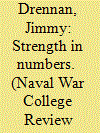

|
|
|
|
|
| Publication |
2014.
|
| Summary/Abstract |
You are a tactical commander tasked with a mission to seek out and destroy one of the enemy's premier capital ships in his home waters. You have two potential striking forces at your disposal: a world-class surface combatant of your own with a 99 percent probability of mission success (Ps = 0.99) or a squadron of eight independently operating, missile-carrying small combatants, each with a chance of successfully completing the mission no better than a coin flip (Ps = 0.5). Do you go with the almost sure thing and choose to send in your large combatant? As it turns out, the squadron of small combatants has an even higher overall Ps but let us now assume that you have advanced to operational commander. You might have more concerns than just overall Ps. What are the defensive and logistical requirements for each option? How much fleet investment are you risking with each option? What will it cost to replace the asset(s) if lost? What capability does the striking force have after successful enemy action (i.e., resilience)? An analysis of these factors, intentionally designed to disadvantage small combatants, is actually overwhelmingly in their favor. The results verify what naval strategists and tacticians have long known-that for certain offensive missions, an independently operating group of even marginally capable platforms can Naval War College Review Vol.67, No.1; Win.2014: p.119-124 Was there something unique to the Japanese that lost them the battle of midway?
|
|
|
|
|
|
|
|
|
|
|
|
|
|
|
|
| 5 |
ID:
133074


|
|
|
|
|
| Publication |
2014.
|
| Summary/Abstract |
W ho are the leaders in our Navy? If "four star admirals" is the response, that is the wrong answer.* The right answer is: every Sailor, insofar as he or she is responsible for other Sailors, is a leader in our great Navy.† From the most junior enlisted personnel to the most senior officers, all are a part of the leadership equation. Junior enlisted personnel need to be recognized as prospective leaders who have the potential for strategic impact through their performance-not as folks "who just follow orders"-just as senior officers are called on to be bold and decisive leaders with the responsibilities of promoting and safeguarding the morale of those under their command. Indeed, all Sailors must understand that we-individually and collectively as the Navy Team-are accountable for the welfare of our shipmates, no matter our respective ranks.
|
|
|
|
|
|
|
|
|
|
|
|
|
|
|
|
| 6 |
ID:
133075


|
|
|
|
|
| Publication |
2014.
|
| Summary/Abstract |
Lieutenant William McCarty Little-a war-gaming visionary-was truly a man ahead of his time.1Although physically sight impaired and medically retired from active naval service, he opted to use his ideational vision and keen mind to support the Naval War College, in Newport, Rhode Island, during its first few years of operation after its founding in 1884. Initially an unpaid volunteer, he was appointed in 1887 as a member of the faculty, where he developed two-sided war gaming at the College-a construct that is still in use at the state-of-the-art facility that today bears his name.
|
|
|
|
|
|
|
|
|
|
|
|
|
|
|
|
| 7 |
ID:
133083
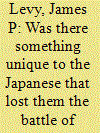

|
|
|
|
|
| Publication |
2014.
|
| Summary/Abstract |
We military historians have a tendency to obsess over the causes of victory and defeat in war. Like economists, we have a profound desire to identify those actions that ensure success or generate failure, and like economists we are not overly good at it. At best, we can state the obvious, as when the disparity of forces between two opponents is extreme, or ascertain certain verities, like "It is good to have the better trained troops," or "Keep your troops better equipped, fed, and rested than your opponent's." At worst, this obsession with winning and losing can lead to a lot of shameless Monday-morning quarterbacking and counterfactual historical speculation.
|
|
|
|
|
|
|
|
|
|
|
|
|
|
|
|
| 8 |
ID:
133081
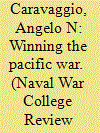

|
|
|
|
|
| Publication |
2014.
|
| Summary/Abstract |
Criticisms leveled at the Japanese for their "ill conceived" or "poorly planned" attack at Pearl Harbor on 7 December 1941 have failed to consider the true depth of vision and professional intellect of its principal architect, Commander Minoru Genda.1 Charges of failure to execute follow-on attacks against the harbor facilities, if any such attacks were planned at all, or to exploit the immediate advantages created in the Central Pacific after the attack are commonly made by both academic and professional military scholars. Genda has suffered the brunt of this criticism. But in fact Genda's plans were neither ill conceived nor poorly assembled-they were just not executed as originally envisioned.
|
|
|
|
|
|
|
|
|
|
|
|
|
|
|
|
| 9 |
ID:
133076
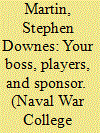

|
|
|
|
|
| Publication |
2014.
|
| Summary/Abstract |
In national-security war gaming there are three classes of senior stakeholders whom I call "the three witches"-critical to the success of a game but with the power to affect negatively its quality. These comprise, first, the war-game director's superior and chain of command; second, the senior players within each game cell; and third, the sponsor of the game and that officer's chain of command. Each of these three stakeholders frequently attempts to influence the design of the war game, even during play itself. For two reasons, such attempts amount to inappropriate interference. First, these stakeholders are not (usually) expert in war-game research, design, development, or production. Second, it is a conflict of interest for them to influence the game's design; such interference puts the credibility of the results into justifiable doubt. The director, responsible for delivering a quality game, must manage these three stakeholders throughout design, play, analysis, and postevent reporting to ensure that the game meets the sponsor's national-security-related objectives. Failure to do so puts the war-game director at risk of following the three witches to a fate analogous to Macbeth's.
|
|
|
|
|
|
|
|
|
|
|
|
|
|
|
|
|
|
|
|
|